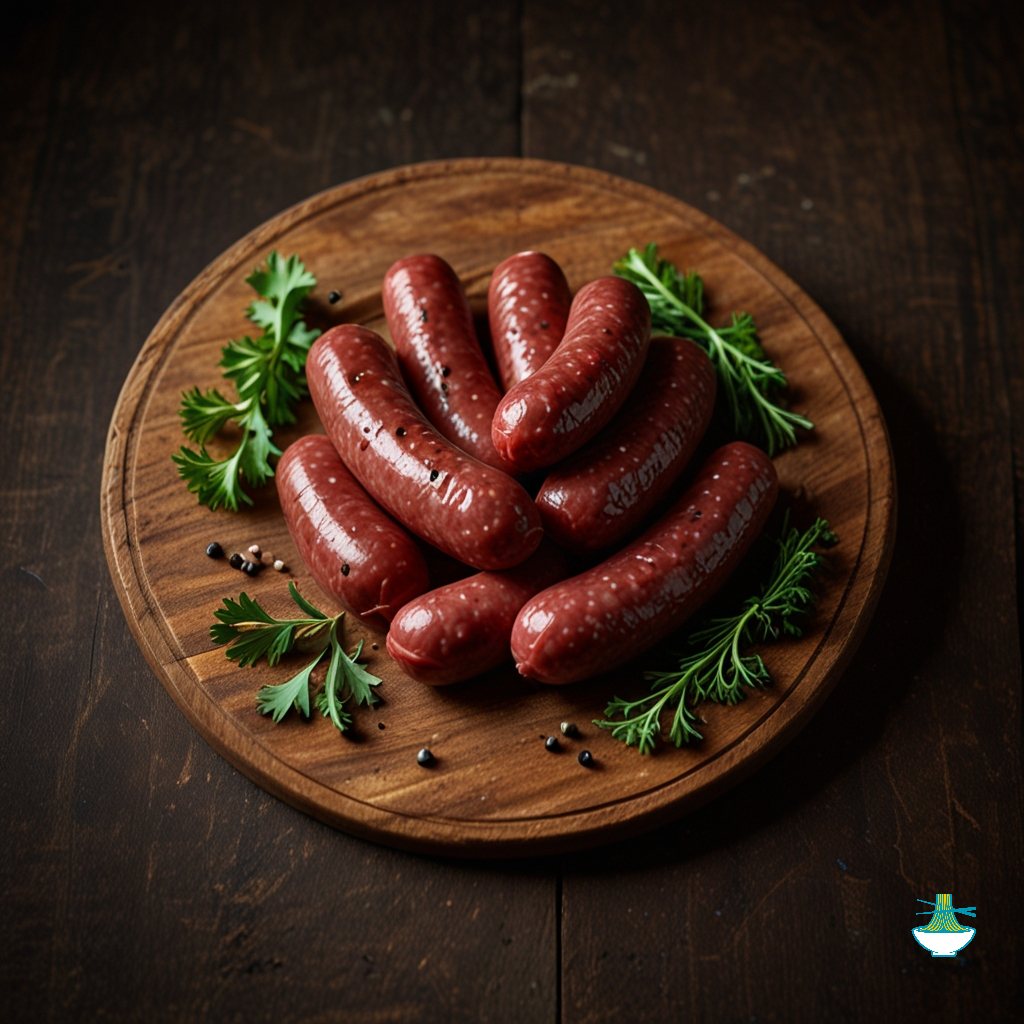Kazy, a cherished delicacy in Uzbek cuisine, is a type of sausage crafted from horse meat. Its history traces back centuries, reflecting the cultural heritage of the region. To prepare Kazy, finely ground horse meat is seasoned with various spices, then stuffed into casings and air-dried. Traditionally served thinly sliced as part of a cold appetizer platter, Kazy offers a unique blend of flavors and textures that delight the palate and showcase the culinary richness of Uzbekistan.
Ingredients:
- 1 kg horse meat (can be substituted with beef or lamb)
- 2-3 cloves garlic, minced
- 1 tablespoon salt
- 1 teaspoon black pepper
- 1 teaspoon paprika (optional)

Method:
1. Start by grinding the horse meat finely using a meat grinder or food processor.
2. In a large mixing bowl, combine the ground meat with minced garlic, salt, black pepper, and paprika if desired. Mix thoroughly to ensure the spices are evenly distributed.
3. Once the mixture is well seasoned, stuff it into sausage casings, shaping them into long links.
4. Hang the sausages in a cool, dry place to air-dry for several days, allowing the flavors to develop and intensify.
5. Once dried, Kazy can be thinly sliced and served as part of a cold appetizer platter, traditionally accompanied by bread, cheese, and fresh vegetables.
This straightforward recipe captures the essence of traditional Kazy preparation while remaining accessible for home cooks.
Nutrition Value:
1. Horse Meat:
- Calories: Approximately 2,080 kcal
- Carbohydrates: 0 g
- Protein: Approximately 208 g
- Fat: Approximately 136 g
- Sodium: Varies depending on preparation
- Cholesterol: Approximately 606 mg
- Vitamins: Rich in B vitamins (especially B12), iron, and zinc
- Minerals: Contains phosphorus, selenium, and potassium
- Nutritional Benefit: Horse meat is a good source of high-quality protein and essential nutrients like iron and zinc, which are important for maintaining muscle health and overall well-being.
2. Garlic:
- Calories: Approximately 13 kcal (for 3 cloves)
- Carbohydrates: Approximately 3 g
- Protein: Approximately 0.6 g
- Fat: Approximately 0 g
- Sodium: Approximately 1 mg
- Cholesterol: 0 mg
- Vitamins: Rich in vitamin C, vitamin B6, and manganese
- Minerals: Contains small amounts of calcium, phosphorus, and potassium
- Nutritional Benefit: Garlic is known for its antioxidant properties and is believed to have various health benefits, including supporting immune function and reducing the risk of cardiovascular diseases.
3. Salt:
- Calories: 0 kcal
- Carbohydrates: 0 g
- Protein: 0 g
- Fat: 0 g
- Sodium: Approximately 2,300 mg (for 1 tablespoon)
- Cholesterol: 0 mg
- Vitamins: No significant vitamin content
- Minerals: Essential for maintaining fluid balance and nerve function
- Nutritional Benefit: While salt is necessary for flavoring food, excessive intake can contribute to high blood pressure and other health issues. Moderation is key.
4. Black Pepper:
- Calories: 6 kcal (for 1 teaspoon)
- Carbohydrates: Approximately 1.3 g
- Protein: Approximately 0.3 g
- Fat: Approximately 0.1 g
- Sodium: Approximately 1 mg
- Cholesterol: 0 mg
- Vitamins: Contains vitamin K and some vitamin C
- Minerals: Contains small amounts of calcium, iron, and manganese
- Nutritional Benefit: Black pepper is known for its pungent flavor and contains compounds that may have antioxidant and anti-inflammatory properties.
5. Paprika (Optional):
- Calories: 6 kcal (for 1 teaspoon)
- Carbohydrates: Approximately 1.3 g
- Protein: Approximately 0.2 g
- Fat: Approximately 0.3 g
- Sodium: Approximately 1 mg
- Cholesterol: 0 mg
- Vitamins: Rich in vitamin A and contains vitamin E
- Minerals: Contains small amounts of calcium, potassium, and iron
- Nutritional Benefit: Paprika adds color and flavor to dishes and provides some antioxidants, particularly beta-carotene from its vitamin A content.
These nutritional values are approximate and may vary based on factors such as preparation method and specific product used.


Comments